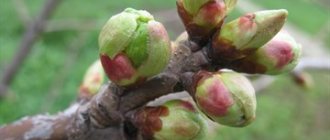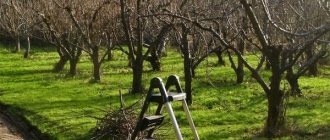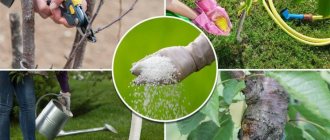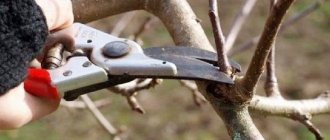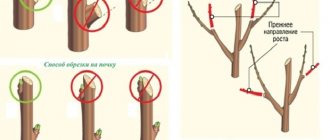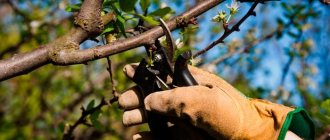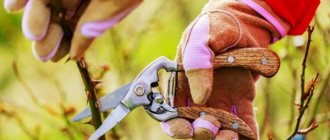Pruning an apple tree in spring or autumn is normal and correct. But in the summer it seems that it’s even a pity to remove all this greenery. This concept is not entirely correct. Summer pruning of an apple tree will bring much more benefits than many may think. There are several features of its implementation.
Pruning an apple tree in summer.
Is it possible to prune an apple tree in summer?
For a long time it was believed that, in principle, it was impossible to prune an apple tree in the summer. This is a misunderstanding. In summer, it is very clearly visible which shoots are superfluous in the crown and which ones do not bear fruit. Proper formative pruning will help stimulate the appearance of new buds and prevent the growth of a large number of shoots.
The formation of the crown helps to rationally use fertilizing and ensure that all fruits have enough fresh air and are evenly illuminated, which directly affects their taste. If you cut off fast-growing shoots that do not bear fruit, then more nutrients will be supplied for fruit formation.
Even an old apple tree responds favorably to summer rejuvenating pruning.
Fruit tree bud blinding
Imagine that in some place of the crown you do not want to have branches. If they appear, you will need to cut them out. But moisture and nutrition were spent on their growth. So it turns out that pruning - a completely justified and necessary technique - inevitably leads to a waste of organic matter. Isn’t it easier to pluck out a bud in advance (bud and eye are synonymous, which is why the term is bud blinding) and thus prevent not only the growth, but also the very appearance of unnecessary shoots?
Of course, trying to remove all the unnecessary (unwanted) buds on a mature tree would be foolhardy. There are many hundreds and thousands of them. And such work is useless. The tree realizes its growth potential through other buds. Including through spare and sleeping ones. Bud blinding is only suitable for young trees. Especially when forming artificial crowns, where it is very important to accelerate the process of crown formation and increase in its volume by economically spending primary production on the growth of only the necessary branches.
The technique of blinding the kidneys is simple. Simply use your fingernails or any sharp knife to remove the main buds planned for this along with the spare ones.
The effect of pruning on fruiting
There are several factors in how summer pruning affects fruiting.
Proper pruning can speed up the process of fruiting on a young plant. If the apple tree is recently planted, it directs all the forces it takes from the soil to the rapid growth of shoots, thereby diligently delaying the date of fruiting. The correct pruning scheme in summer will speed up this procedure.
Very often, it is in the summer that, in parallel with pruning the apple tree, the shoots are deflected and secured horizontally in order to also stimulate the appearance of flower shoots. In the summer it is also necessary to remove fatty shoots and tops, because they will not bear fruit, but greatly thicken the crown.
Columnar varieties
The rules for pruning columnar trees are even simpler . Since they form few side branches, it is enough just to control their growth by pinching off the excess.
All shoots growing perpendicularly must be removed .
Particular attention should be paid to growth in June - this is a period of accelerated tree growth.
Attention! Under no circumstances should the apical bud be cut off. This will cause completely unnecessary branching and thickening of the column.
Trimming scheme
For apple trees that have not yet reached five years of age, there is one main pruning scheme - removing almost all fattening branches. This is done in order to leave only that part of the crown that is the base and fruit-bearing.
Scheme for summer pruning of an apple tree.
In the fourth year of the apple tree’s life, it is necessary to cut off the central conductor at a level of 3-4 meters in the summer. This is done in order to stop height growth. It is also necessary to clear the crown of crooked and painful shoots.
For slightly older trees the scheme is slightly different. In addition, it will be necessary to remove those branches that dry out, are damaged by pests and have stopped bearing fruit.
Tools
The main tool is a pruner. It is suitable if you are removing branches whose thickness does not exceed 2 cm. If the shoots are thick, it is better to use a lopper. Its advantage is its durability (it will not break during work). A lopper differs from a secateur only in having longer handles.
Knives are also used. Such tools are less in demand, because with their help it is difficult to carry out high-quality and fast work. If you decide to use a knife, choose ones with a sharp and strong blade. They can't be broken. They replace pruning shears.
If you are cutting large, thick branches, use pruning saws. The difference between a garden saw and a regular saw is small. The only difference is that the garden type is used for living branches.
Additional inventory
You will need gloves to protect your hands. Comfortable shoes will ensure comfortable work and will not cause fatigue in your feet. Closed clothing and safety glasses will protect your skin and eyes from sawdust.
To increase comfort during work, use a ladder. With its help, it is easier to reach the highest areas on the tree. If you have to remove large branches that are larger than 35cm in diameter, use a chainsaw to make the process easier.
Before use, each instrument is disinfected with a solution of potassium permanganate (40 g per 10 liters of water). This way you will not introduce bacteria or viruses into the tree and maintain its health.
Basic rules for pruning an apple tree
There is one pruning rule that must always be taken into account. You cannot remove more than a third of the total mass of the vegetative system of the apple tree at one time. Otherwise, the plant will be sick for a long time and may not even recover. However, it is necessary to take into account that if a lot of extra branches are left, the harvest becomes smaller and becomes significantly smaller.
Crown formation
The crown of apple trees is often formed in a tiered pattern, where the bottom row will be the longest and the length of the shoots will decrease upward. However, there are many different options for forming a crown that will serve as decoration. Modern trends create various fancy shapes on trellises, but the principles for pruning are always the same.
For young trees
On young trees that have not yet had fruits, formation begins in the first year and ends when the first fruits appear. More precisely, it does not end, but simply passes into another form.
Scheme for pruning a young tree.
Young apple trees need to be adjusted according to the height of the trunk in a timely manner: it is cut off and the side shoots are partially removed to direct the growth of skeletal branches and all branches.
Rejuvenation
To rejuvenate the apple tree, you will need to cut much more. Branches that are completely withered, those that do not bear fruit, and those that compete with the main shoots are removed. In summer, anti-aging pruning is carried out once, and it is recommended to repeat the procedure a second time in winter.
For old trees
To properly rejuvenate an apple tree in adulthood, you need to remove the vertical two-year growth, and remove all old branches to a height of 6 meters. It is very important to seal all cuts with a diameter of more than 1 cm with garden pitch.
Scheme for pruning an old apple tree.
Why bend branches of fruit trees?
It has long been noted that during vertical growth on branches, the strongest shoots grow from the apical and adjacent buds. As the branch moves from a vertical to a horizontal position, the awakening of the buds increases, and the growth of shoots from the top to the base of the branch is leveled out. The shoots are usually weaker, but more prone to fruiting.
The essence of this phenomenon is explained by the peculiarities of exchange. In former times, peasant gardeners did not particularly understand biology, but they knew that a wildly growing tree that did not want to bear fruit had to be put to shame. They hang pieces of bricks, cobblestones, old bast shoes on its branches, and the poor tree stands in plain sight for everyone. Shame, disgrace. How can you not bear fruit here?
However, if the branches are bent incorrectly, with a very large number of bent branches, as well as in plants of a number of varieties characterized by natural drooping growth, strong vertically growing fatty shoots - tops - inevitably appear on the bent branches. They consume that part of the water and mineral nutrients that the upper part of the horizontal and drooping branches is not able to use.
Recently, bending branches has become popular again. In some forms of crowns (spindle-shaped, fan-shaped, various palmettes) the entire pruning system is built on the bending of branches, and even in the crowns we are accustomed to they rarely do without this technique.
If you need to enhance the growth of some branch, give it a position close to vertical. It is necessary to weaken, strengthen fouling, accelerate fruiting - bend it to a horizontal or drooping position. You can change the orientation of the branches from spring until almost the end of summer. When it's convenient. If you bend the branches in autumn or winter, they will not acquire the desired position. Remove the fasteners and they will snap into place. You won’t suddenly bend a thick branch. And you make shallow cuts or cuts at the bottom of the branch at the bend - and it will work.
If the angle of departure is less than 40°, the branch may break off when bending. To prevent this from happening, you must first strengthen it. This is achieved by tightly tying the base of the corner. When bending, make sure that there is no arc, otherwise strong tops will form on it. Tinkle with them later. Secure the branch in position with string or twine. Secure one end with a free loop to the branch, and tie the other to the trunk, trunk, lower branch, to a peg driven into the ground, to a trellis. To prevent the string from cutting into the bark, place something under it - a piece of rubber, just some sticks.
Advantages and disadvantages of summer pruning
Like any other procedure, pruning an apple tree has its pros and cons.
The advantages include the ability to speed up the onset of fruiting, increase productivity, and direct the apple tree’s forces to form a crown and a sufficient number of fruits.
It has been noticed that in summer plants can easily tolerate manipulations in the crown.
But there are disadvantages. If you cut too much, the plant will take a very long time to heal its wounds and may not have time to prepare for winter, which is why it will suffer from low temperatures. Also, some gardeners note the fact that in summer there is a very high probability of infection by various fungi and infections that can develop on apple trees, and which are much easier to penetrate into the tissues through cuts. The same applies to pests.
Girding of branches
If the tree is growing wildly and does not want to bear fruit, if neither pruning nor bending the branches helps, try, maybe girdling the branches will have an effect. Its essence is the weakening or almost complete cessation of the outflow of assimilates from the branch where they were formed. To do this, you just need to remove a strip of bark around the branch to interrupt the transport routes - cut the vessels.
The technique of ringing branches is incredibly simple. Remove a strip of bark from the base of the branch and that's it. You can remove it in a ring, in a spiral or in half rings. Work as convenient and pleasant as possible.
Make one cut in the bark at the intended location, move up or down about 1 cm from it, and make another parallel to the first. Then carefully remove a strip of bark from between these cuts. Cover the wound with garden varnish or wrap it with film or insulating tape to prevent drying out of the exposed tissue of the branch.
The outflow of photosynthesis products from the leaves of ringed branches will practically stop. This will promote the differentiation of buds into flower buds. The branch will have to set flower buds and bloom next year. In the future, depending on their condition, you can leave the ringed branches so that they continue to bear fruit.
Some of the ringed branches may be too weak or in strong shade. Cut them out. They still won’t produce good fruit. It is important that the main goal of ringing - to shift the metabolic process in the plant from purely vegetative to generative activity - has already been achieved. Fruiting has begun.
Collect bad apples
When is the right time to prune an apple tree - in autumn or spring? It is possible for the tree to become infected in areas of fresh cuts, so definitely in the spring. But if you prune in the autumn, it is necessary to remove possible sources of disease from the tree.
From the canopy of the tree, inspect the branches and collect any brown, mummified fruit affected by the fungus and bury them in a compost bin or dispose of them. These actions will help preserve the tree and prevent existing infections from spreading through fresh cuts.
Finished tree
Once you've finished pruning, you should have a beautiful tree with noticeably increased internal light levels, better crown ventilation, and a clear trunk of unwanted branches. Also read our article “How to propagate an apple tree.”
Similar articles:
Step-by-step instructions on how to plant...
How to care for perennial carnation: step-by-step instructions
How to care for myrtle at home:...
Features of the procedure
The gardener will have to work hard to bring the crown into the desired form for no more than 4-5 years. Once this milestone is overcome, he will only have to periodically trim the young shoots, which is not difficult. But the procedure itself can cause confusion at the initial stage (from the moment of disembarkation). Some trees are tied to a trellis, others are dwarf or semi-dwarf (for example, the President variety). This will have to be taken into account both when planting and during subsequent pruning.
Trellis apple trees
Working with trees on a trellis
To ensure that the strongest shoots grow in two directions, the side branches are attached at an angle of 90 degrees to the trunk. The lower shoots are tied horizontally to the trellis, and the upper shoots are shortened so that the cut is located above the shoots (45-50 cm). On two- and three-year-olds, all lateral shoots, as well as the competitive shoot, are cut off, the upper shoot is pruned in the same way as during the first pruning. The sprouts that form should grow in a slightly elevated position.
All summer, gardeners tie up the upper branches, slightly lifting them. 2 strong sprouts, formed by autumn from the upper trunk of the future apple tree after spring pruning, are tied to the trellis at an angle of 90 degrees. They will become the second row of crown branches.
Be sure to trim off all apical shoots after winter. If this is done correctly, buds will appear on the sides. They will become the third row of the crown. All shoots that rush upward are uprooted at the base.
Note! On a trellis, the upper branches should be no longer than the lower ones. The gardener should not allow the tree to grow; a height of 1.8-2 meters is considered optimal
creeping tree
Pruning dwarf trees
Dwarf apple trees are pruned twice per season - in spring and autumn, but after the formation of the apple tree is completed, approximately 2 years after planting. In this case, the maximum permissible height of the seedling should not exceed 50 cm. Everything above this mark must be cut off.
Pruning a dwarf is no different from caring for a tree of standard sizes, except that the length of the cut branches is not 40, but 20 cm.
Advice from experienced gardeners
If you follow the general recommendations, the pruning process will not cause difficulties.
Useful tips from experienced gardeners:
- Pruning is carried out only on a suitable day. It shouldn't be hot or rainy.
- Use only sharp instruments. This way the tree is less damaged.
- Removing young shoots does not harm the apple tree, but prevents the formation of a dense crown.
- Large branches are cut several times. No more than 1/3 of the length is removed at one time.
- Be sure to cut off competing shoots.
- Each cut is treated with garden varnish.
Aftercare
Pruning an apple tree is stressful. After the procedure, the tree needs additional care.
In the spring and summer, after pruning, fertilizers with a high content of nitrogen, phosphorus and potassium should be applied. Ammofoska, saltpeter, urea, diluted chicken manure and mullein have proven themselves well.
If pruning was carried out at the end of summer or autumn, then preference is given to compositions with a high content of potassium and phosphorus.
Important! Nitrogen fertilizing at the end of summer promotes the active growth of young shoots. The thin bark is not able to withstand severe frosts, which leads to frostbite of the branches and death of the tree.
After feeding, the trees are watered abundantly with water - 2-3 buckets for each square meter.
Research results
According to studies conducted in experimental plantings of VNIISPK, with the help of regular pruning, systematic rejuvenation and replacement of overgrowing branches, it is possible to maintain the compact size of the tree with a predominance in the crown of fruit branches no older than 4-5 years, on which the main fruiting is concentrated. The conclusions of experts were made based on a study of the following varieties: “Sinap Orlovsky”, “Northern Sinap”, “Uelsi”, “Orlik”, “Orlovskoe Polosatoe”, “Veteran”.
Annual crown care helps increase the yield and size of apples
Measures such as reducing tree height, limiting crown width and thinning affected both productivity and the quality of apples
There was an increase in the average weight of fruits and the number of large ones, which is especially important when growing apple trees with small fruits, such as “Northern Sinap”, “Orlik” and “Veteran”
General rules
Despite the fact that this procedure has many nuances and depends on a large number of factors, there are several universal rules on how to properly trim an apple tree. They are suitable for any method and fit into different schemes. A small step-by-step guide on how to do this, suitable for beginners planning to grow this tree in their garden.
The first step is to prune the apical shoot, correcting the tree's growth and removing crow's feet. The second stage is to trim certain branches:
- intersecting, intertwined, intersected - from this tangle, one, the most deformed one, is removed;
- growing towards the trunk, inside the crown;
- growing downwards;
- top;
- thickening the crown (growing too close to each other);
- forming a fork at the tips (only the lower part needs to be removed).
After all the excess branches are cut off, the crown will become thinned out and freer. This will open access to the barrel, which you can also work with. All young growth is carefully removed from it, starting from the very root and ending with the top. In this case, care must be taken not to damage the bark.
